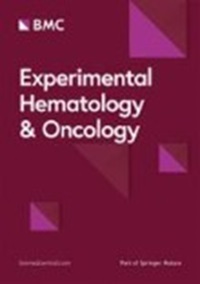菌株依赖性调节因子会加剧由 GATA1 缺失引起的家族性白血病
IF 9.4
1区 医学
Q1 HEMATOLOGY
引用次数: 0
摘要
GATA1 在红细胞生成过程中的分化、增殖和凋亡中起着关键作用。我们开发了一种 Gata1 基因敲除等位基因(Gata1.05),其 GATA1 表达量仅为内源性水平的 5%。在杂合了 Gata1.05 和野生型等位基因的雌性小鼠中,我们观察到它们在出生后三到六个月易患红细胞白血病。由于 Gata1.05 的雄性后代在妊娠期无法存活,我们最初将杂合雌性小鼠饲养在 C57BL/6J 和 DBA/2 品系的混合遗传背景中。这些小鼠中约有 30% 可重复发生白血病,但另一部分却没有发生白血病,尽管它们体内有大量白血病前红细胞。这些观察结果促使我们假设,遗传决定因素可能对 Gata1.05 驱动的造血前体发展为全面白血病有潜在影响。在对回交到 C3H/He、BALB/c、DBA/2、C57BL/6J 和 129X1/SvJ 品系的 Gata1.05/X 小鼠进行的初步研究中,我们发现 C57BL/6J 和 129X1/SvJ 的背景明显加快了 Gata1.05/X 小鼠白血病的发生。相反,C3H/He、BALB/c 和 DBA/2 的背景并没有在很大程度上改变 Gata1 突变的影响。这表明遗传修饰因子的存在加剧了 Gata1.05 白血病的发生。随后的队列研究评估了在 BALB/c:129X1/SvJ 和 BALB/c:C57BL/6J 混合背景下的 Gata1.05/X 小鼠。在这些背景中,Gata1.05 驱动的白血病在 129X1/SvJ 背景中表现为常染色体显性模式,而在 C57BL/6J 背景中则表现为常染色体隐性模式。据我们所知,这项研究首次提供了基于白血病相关基因特征的遗传修饰因子可以重塑结果的证据。本文章由计算机程序翻译,如有差异,请以英文原文为准。
Strain-dependent modifiers exacerbate familial leukemia caused by GATA1-deficiency
GATA1 plays a critical role in differentiation, proliferation, and apoptosis during erythropoiesis. We developed a Gata1 knock-down allele (Gata1.05) that results in GATA1 expression at 5% of endogenous level. In female mice heterozygous for both the Gata1.05 and wild-type alleles, we observed a predisposition to erythroblastic leukemia three to six months after birth. Since no male Gata1.05 progeny survive gestation, we originally maintained heterozygous females in a mixed genetic background of C57BL/6J and DBA/2 strains. Around 30% of these mice reproducibly develop leukemia, but the other subset did not develop leukemia, even though they harbor a high number of preleukemic erythroblasts. These observations prompted us to hypothesize that there may be potential influence of genetic determinants on the progression of Gata1.05-driven hematopoietic precursors to full-blown leukemia. In an initial examination of Gata1.05/X mice backcrossed into C3H/He, BALB/c, DBA/2, C57BL/6J and 129X1/SvJ strains, we discerned that the backgrounds of C57BL/6J and 129X1/SvJ significantly expedited leukemia onset in Gata1.05/X mice. Conversely, backgrounds of C3H/He, BALB/c and DBA/2 did not substantially modify the effect of the Gata1 mutation. This indicates the existence of genetic modifiers that accentuate Gata1.05 leukemogenesis. Subsequent cohort studies evaluated Gata1.05/X mice within mix backgrounds of BALB/c:129X1/SvJ and BALB/c:C57BL/6J. In these settings, Gata1.05-driven leukemia manifested in autosomal dominant patterns within the 129X1/SvJ background and in autosomal recessive patterns within C57BL/6J background. To the best of our knowledge, this study provides the inaugural evidence of genetic modifiers that can reshape the outcome based on leukemia-associated gene signatures.
求助全文
通过发布文献求助,成功后即可免费获取论文全文。
去求助
来源期刊

Experimental Hematology & Oncology
Medicine-Oncology
CiteScore
12.60
自引率
7.30%
发文量
97
审稿时长
6 weeks
期刊介绍:
Experimental Hematology & Oncology is an open access journal that encompasses all aspects of hematology and oncology with an emphasis on preclinical, basic, patient-oriented and translational research. The journal acts as an international platform for sharing laboratory findings in these areas and makes a deliberate effort to publish clinical trials with 'negative' results and basic science studies with provocative findings.
Experimental Hematology & Oncology publishes original work, hypothesis, commentaries and timely reviews. With open access and rapid turnaround time from submission to publication, the journal strives to be a hub for disseminating new knowledge and discussing controversial topics for both basic scientists and busy clinicians in the closely related fields of hematology and oncology.
 求助内容:
求助内容: 应助结果提醒方式:
应助结果提醒方式:


